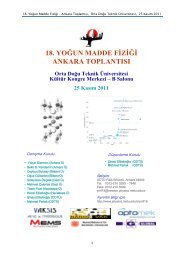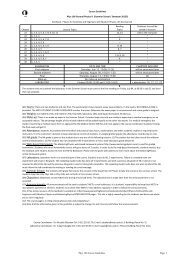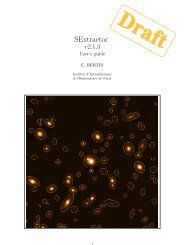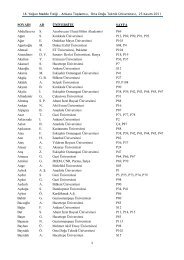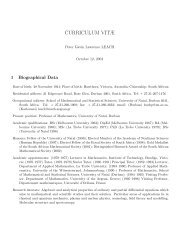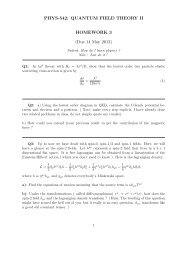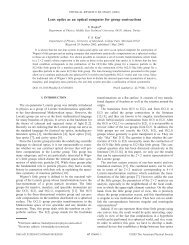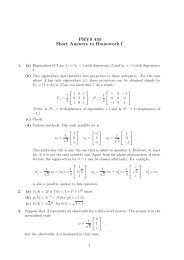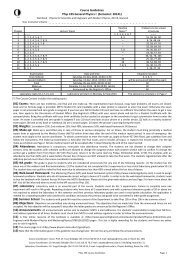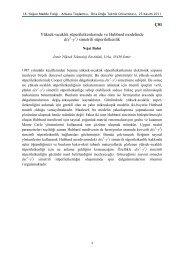A Crash Course on Quantum Mechanics
A Crash Course on Quantum Mechanics
A Crash Course on Quantum Mechanics
Create successful ePaper yourself
Turn your PDF publications into a flip-book with our unique Google optimized e-Paper software.
Postulate 1: States. For every isolated physical system, there is a separable, complexHilbert space describing the states of the system, such that- Every normalized vector, |ψ〉, represents a state- To every physically realizable state there is a normalized vector that represents it- Overall phase factors do not change the state (in other words |ψ〉 and e iθ |ψ〉 representthe same state)(The three statements above basically tells us that there is a <strong>on</strong>e-to-<strong>on</strong>e corresp<strong>on</strong>dencebetween states and rays in the Hilbert space.)- There is a linear, unitary time-evoluti<strong>on</strong> operator Û(t 2, t 1 ), which, when acts <strong>on</strong> thestate at time t 1 gives the state at time t 2 . (In other words, if |ψ(t)〉 is the state of thesystem at time t, then Û(t 2, t 1 ) |ψ(t 1 )〉 = |ψ(t 2 )〉.)Postulate 2: Observables. For every measurable quantity A, there is a corresp<strong>on</strong>dinghermitian operator  such thatIf λ n are its eigenvalues and |α n 〉 are its eigenvectors chosen such that they form anorth<strong>on</strong>ormal basis |α n 〉 = λ n |α n 〉 , 〈α n |α m 〉 = δ nm ,and if A is measured when the system is in state |ψ〉,- The result is <strong>on</strong>e of the eigenvalues, λ n ,- the probability of that result is p n = |〈α n |ψ〉| 2 ,- and the state collapses to |α n 〉 after the measurement.The Schrödinger equati<strong>on</strong> itself can be obtained from the time evoluti<strong>on</strong> operator wherewe define the Hamilt<strong>on</strong>ian at time t bywhich implies that Ĥ(t) is hermitian.i¯h ∂ ∂tÛ(t, t 1) = Ĥ(t)Û(t, t 1) ,Schrödiger’s Cat. An interesting feature of the first postulate is that it allows us totake linear combinati<strong>on</strong>s of a number of states and in this way c<strong>on</strong>struct new, physicallyrealizable states. The linear combinati<strong>on</strong>s of vectors are usually called superpositi<strong>on</strong>s,a word borrowed from wave phenomena. The possibility of forming superpositi<strong>on</strong>s isthe most important distinctive feature of quantum mechanics that separates it from theclassical <strong>on</strong>es.A strange example is proposed by Schrödiger. He also showed how such states can beformed in practice. C<strong>on</strong>sider a cat as a physical system. We know that there is a Hilbertspace that describes all possible states of that cat. Let |A〉 be <strong>on</strong>e particular state where19



